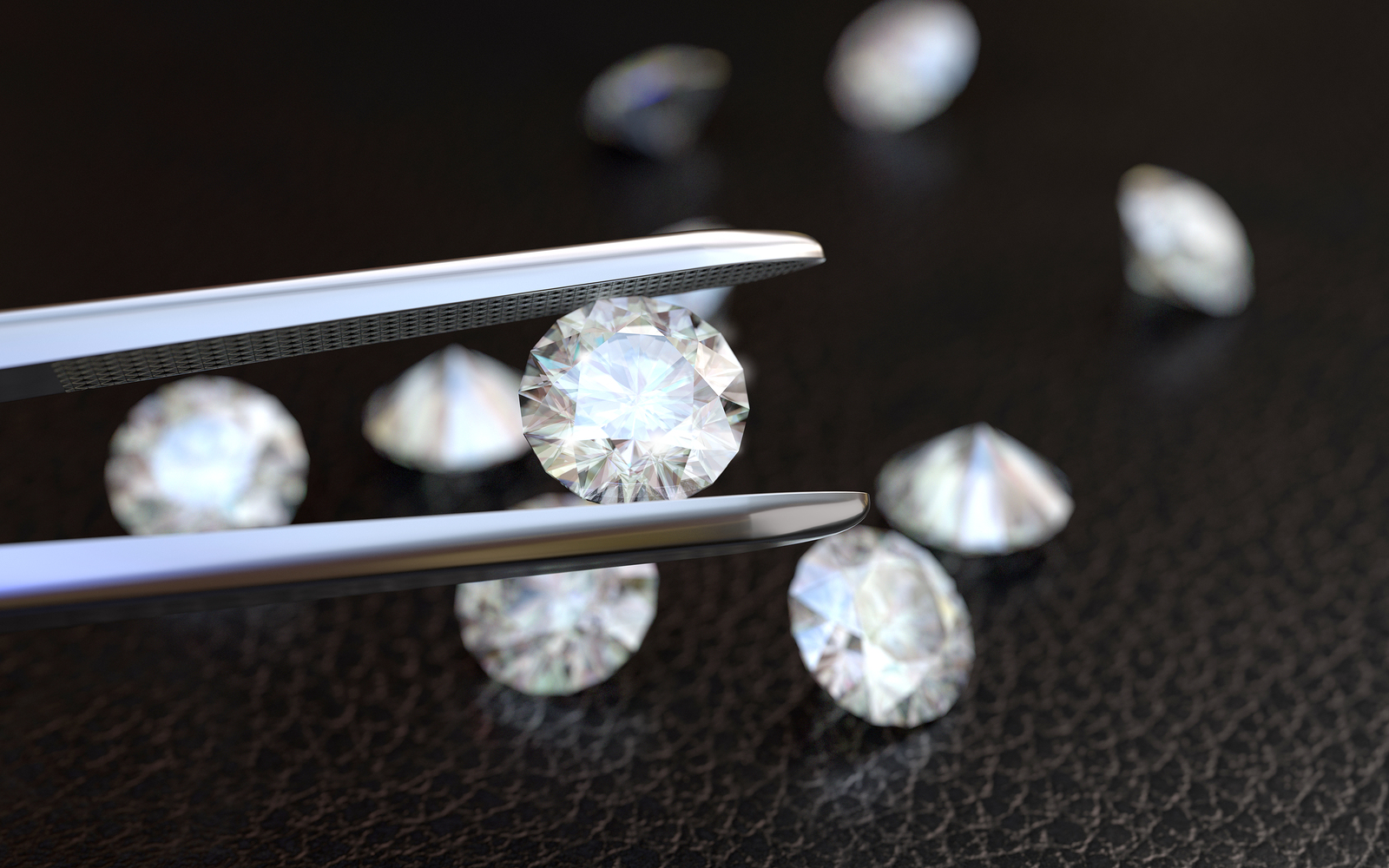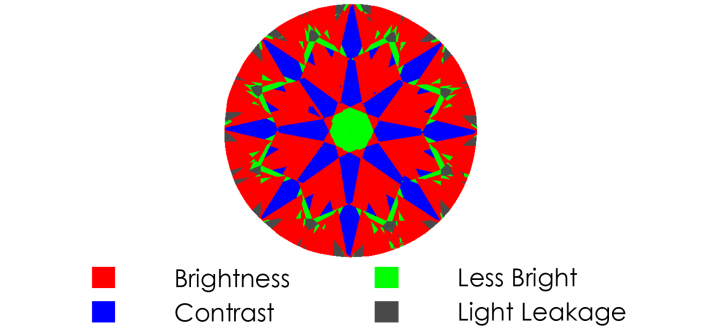
By John Carter, CGA, Jack Lewis Jewelers
Buying finished jewelry is so different than buying loose diamonds, mainly because our diamond buying is a year-long process. We are constantly searching for diamonds, whether it be something specific that a client has asked to see or just something that we need to meet our day-to-day inventory needs.
Because of this never-ending search for perfect diamonds, our ability to spot the good ones remains pretty sharp. I’ve always said that a really well-cut diamond has a sort of “it factor,” meaning after you’ve seen enough of them, you just know the special ones with a glance. When it takes your breath away—right away—that’s the one.
When I closed Part I of this blog, I promised you that we would discuss exactly what goes into making a diamond an AGS Ideal® cut. How do you tell the difference? And is it worth the extra money? I stressed out so much about living up to my promise that I reached out to my good friends at American Gem Society Laboratories to make sure I kept it all straight. So here we go:
What exactly is “cut” as it relates to diamonds? The American Gem Society (AGS) and AGS Laboratories say, “The cut of a diamond refers to how well the facets of a diamond interact with light, the proportions of the diamond, and the overall finish of the diamond.” (Source: americangemsociety.org/understanding-diamond-cut-the-4cs-of-diamonds)
Facets, light interaction, proportions, and finish may seem like small things, but their influence on the beauty of a diamond is enormous. AGS makes it really easy to understand with their 0 to 10 grading system, with zero (0) being the highest cut grade (ideal) a diamond can receive and 10 being the lowest. However, this apparent simplicity is deceptive because it requires very careful analysis of all things that make up that diamond.
It used to be that diamonds were “cut graded” primarily by their proportions, but AGS revolutionized diamond grading in 2005 when they released their long-awaited Light Performance Cut Grading System.
This method uses patented software technology to measure the attributes that are most important to the beauty of your diamond: Brightness, Fire (spectral color), and Contrast. The combined impact of these factors is what breathes life into your diamond and makes it sparkle! In other words, they are the secret ingredients of the “it factor” that I mentioned above.

0 means the cut grade is the best it can be.
Because every facet is considered, every cutting mistake and design flaw can impact the final Cut Grade. Consequently, the AGS Performance Cut Grade system is the most technologically advanced and scientifically rigorous system in the world and represents the highest standards in cut grading.
These ranges make it easier to understand, but I’ve seen more than my share of clients get caught up in these numbers, and they forget to ask themselves one thing: how does the diamond actually look? Is it bright and sparkly with a lot of life? Yes? Then don’t let one number encourage you to cast a pretty diamond onto the scrap pile.
What’s really cool from a gemologist’s point of view is that the same technology used to compute the Cut Grade also produces a color-coded image of the diamond which allows you to understand its light performance.

The above is called an ASET image. ASET stands for Angular Spectrum Evaluation Tool. (There will be a test later, haha.) For customers like you, this is a crucial piece of technology because it demonstrates the way light interacts with your diamond. It’s much easier to see and understand a diamond’s beauty through this image than to listen to a scientific explanation, right? We can show you your diamond’s ASET image right at Jack Lewis, and you can even snap a picture of it to carry around with you or share on social media.
Additionally, The ASET shows the “optical symmetry” of your diamond. For example, in the image above, the eight symmetrical arrows prove that the diamond was cut with a high degree of craftsmanship and artistry.
The simple fact remains that while what we do isn’t the most complicated job on the planet, it really does take a scientific approach and an educated eye to do all of the above. A life spent in the diamond business can teach the right grader, gemologist, or diamond buyer the skills they need to be able to make proper decisions and assign the right grades which determines the right price.
The average consumer looking to find just the right diamond for the love of their life does not have the time to become an expert during their brief shopping experience. They can Google, research, and look at hundreds of diamonds, but they will still need to seek out a properly credentialed and trustworthy diamond professional to help them find what’s right for them. That’s the real dilemma when you’re looking for a jeweler isn’t it….trust?
I once had a client at the diamond counter who told me that Jack Lewis Jewelers was the 15th jewelry store he had visited! He was so confused and so frustrated with the process that he was almost in tears. I can understand why. One jewelry store will tell you one thing, and then another will explain it another way, and on top of it, they are all trying to sell you whatever is in front of them. Just about all of them mean well and are honest, but it can be a lot to process.
I asked if I could give him some advice and he reluctantly said, “Sure.” I said, “Just stop. Stop looking. Pick the place that makes the most sense with as little sales talk as possible. Then trust that person to walk you through the process with an education along the way.” I went on to say that I hoped that was me, but if not, he needed to find the person he could most relate to and trust.
I could tell when I gave him that advice that I had lifted a great weight off of his shoulders. The process can be overwhelming and the diamond grading scale can be a large part of why. I understand that retailers don’t always do a good job of explaining the process, so it is really important to find one who takes the time to do just that. I’ve found it’s the best way to establish a relationship with my clients—and dare I say it—a friendship. I’m happy to say that client did choose me! This occurred over 10 years ago and over the course of a few years, he even sent me several of his friends.
You can see we’ve taken this from an explanation about Cut Grade to the importance of establishing a relationship with someone you can trust. My journey to this destination was no accident. So let’s cut to the chase: at some point, buying a diamond becomes a leap of faith, and Cut is the most complicated part of the buying process as well as being the most essential characteristic in determining beauty. I believe it’s an understatement to say that it pays off to have an expert help you with that part. And at Jack Lewis, we’re ready to walk you through it.
I want to thank my friends at the American Gem Society (AGS) and AGS Laboratories for helping me with this blog. In particular, Jason Quick, who is the Laboratory Director and a mad genius who understands diamonds in ways I can only imagine. Jason and the team at AGS are on the forefront in the jewelry industry because consumer protection is at the very heart of everything they do.
Like the young man in my story, I hope you also choose Jack Lewis Jewelers, but we realize we can’t sell everyone a diamond. If you’ve ever wondered how you can find a jeweler you can trust, start with us if you can…but if not, AGS has you covered. Visit Find a Jeweler at www.americangemsociety.org/find-a-jeweler, type in your zip code and visit a great store. Every retail member of the American Gem Society adheres to a strict code of ethics that help them remain dedicated to the education of their clients.